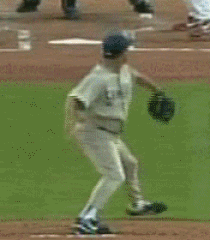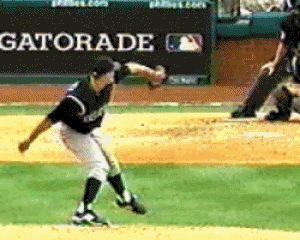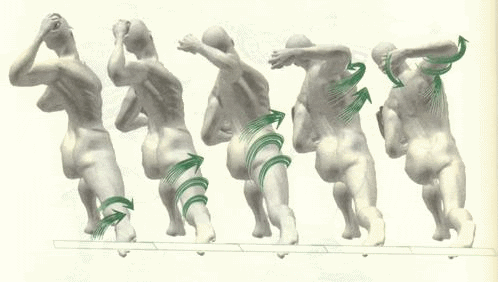Sorry for delay, if you’re still out there, some thoughts on the Kevin Brown and Juan Marichal clips.
We can see that the different release points produce two different back foot reactions within the same pitcher. So which reaction is better? To make a value judgment between them in this instance seems misguided, as the differences appear to be primarily a natural reaction to different postures and release points.
The above example suggests that what might be a good drag line for one way of throwing is not so good for another. Hence having just one universal continuum from, bad to good, for all types of pitchers doesn’t appear comprehensive enough IMO.
Of course, to the scientifically minded, the connection between how the back foot reacts, and greater mechanical efficiencies, would likely have to be proven using motion analysis data across a wide variety of subjects. For example does the back foot reacting inward or outward stem from greater or lesser hip velocity? It’s possible that the ASMI already has all the necessary data you’d need in their “elite” pitchers data bank. Someone would have to go through the numbers looking for connections between the things your interested in.
All I can do with video is try and offer some constructive speculations, which is usually a good beginning and certainly okay for now.
Here are some links to a submarine pitcher who appears to have a rather extreme immediate inward reaction.
http://www.youtube.com/watch?v=uZJzNTxgIx0
http://www.youtube.com/watch?N...e=fvwp&v=cadtGulEJZw
It seems obvious enough that as one increasingly bends over to the right from the waist they will need to counterbalance with a leftward leg slide, and yet other variables, such as stride direction and length, tempo, timing of leg extension and back foot turn over…work against simple uniformity, even among submariners.
Check out all these down-unders!
http://www.youtube.com/watch?v=RQCz6nSHuwA
Looking back through my video archives I’ve yet to recognize a convergence of drag line types or back foot reactions among elite level throwers, rather I see a diversity that can only be deciphered one pitcher at a time. Here is a clip of two hard throwing RH’s, Kyle Farnsworth and Brain Wilson.
Here is another link to Wilson.
http://www.youtube.com/watch?v=ntFrmmv9fQY

Farnsworth goes in initially, Wilson mostly out to the right.
Maddux is another pitcher who might go forward a smidgen before making a hard right. What is your take on his drag line?

Here is a good overhead link.
http://www.youtube.com/watch?v...49Vc&feature=related
Then there is the interesting case of a leaping Jordan Walden who goes immediately opposite arm side. His leaping action appears to be creating and interesting response in the back foot.

No doubt drag lines and back foot reactions should be able to tell us something about a pitchers delivery. However when individual variations combine with an infinite number of ways to throw a baseball unraveling cause and effect is not so simple.
Seeing through a haze of complexity to discover a genuine unifying pattern is a great moment in human thought and I commend your efforts in this direction. However, after having been down these roads several times, you’ll have to forgive me for becoming a little suspicious of answers which appear too easy, and “absolutes”, which, after some additional research, prove to be just more “variables” a few months later. It might be good marketing to simplify the package but the reality is often more complicated.
Continuums usually appear closer to reality than narrowly defined absolutes, but even these broader frameworks will sometimes obscure the unique. In my experience you only arrive at true simplicity after having worked through a very large pile of complexity…and obviously I’m still shoveling.
PS,
As I mentioned before one of the most instructive drag lines turns out to be a pitcher with practically no drag line at all. His back foot turns over with very little separation from the rubber until after release, contrast this with the distance Lincecum comes off the rubber.
http://www.youtube.com/watch?v=lch6IwadoQ8


I’m not suggesting everyone adopt his technique in a specific way, rather, keep him in mind when thinking about where the true source of power in a delivery comes from.

I’m done…
